Phototherapy is a conventional therapy that involves exposure to a wide variety of light sources, such as light-emitting diodes (LEDs), ultraviolet (UV) light, as well as halogen lights. Currently, phototherapy has been broadly used for treating many kinds of diseases, including but not limited to vitiligo, mood or sleep disorders, skin disorders, and cancers.
Among them, three main types of UV light, psolaren ultraviolet-A (PUVA), broadband UVB (BUVB), and narrowband UVB, have been used to inhibit skin inflammation and reduce skin cell growth. However, previous studies have demonstrated that phototherapy treatment using UV lights can cause several side effects, such as itchy skin, skin redness, or even skin cancer. As a result, a full range of combination therapies of immune checkpoint therapy and phototherapy have been generated to avoid adverse events of monotherapy alone and improve clinical outcomes in patients.
 Fig.1. Cancer treatment using the combination of phototherapy and immunotherapy.1,2
Fig.1. Cancer treatment using the combination of phototherapy and immunotherapy.1,2
Recently, immune checkpoint therapy and phototherapy in combination are considered the perfect strategy for treating various types of human diseases, especially cancers. Current research has illustrated that immune checkpoint therapy can trigger strong immune responses to inhibit tumor progression and control distant metastases. Phototherapy initiates an anti-tumor immune response by inducing the death of primary tumor cells. The combination therapy of these two can present an antigen presentation synergy effect to further trigger antitumor activity at the treatment site. For example, several immune checkpoint inhibitors (ICIs) and monoclonal antibodies (mAbs), such as CTLA-4 mAbs and PD-1/PD-L1 mAbs, have been combined with PUVA to treat melanoma. The results have indicated that these combination therapies can promote synergistic immunomodulatory effects and enhance the survival time of tumor-bearing mice.
Besides, the encouraging results from animal studies have promoted clinical applications of immune checkpoint therapy and phototherapy-based combination therapies. In particular, two approved PD-1 mAbs have been combined with UV therapy to treat patients with late-stage cancer. The data derived from large-scale clinical studies have revealed that it can prevent tumor growth, control tumor metastasis, and improve the overall survival of patients.
Creative Biolabs offers integrated high-quality novel immune checkpoint molecule discovery solutions and a series of immune checkpoint drug development that span the entire development chain from discovery to commercialization. Please do not hesitate to contact us for more detailed information.
References
All listed customized services & products are for research use only, not intended for pharmaceutical, diagnostic, therapeutic, or any in vivo human use.
USA
Tel:
Fax:
Email:
Copyright © 2026 Creative Biolabs. All Rights Reserved.